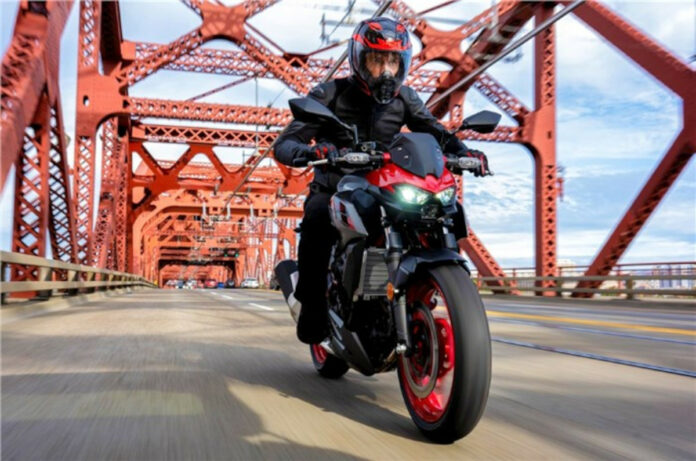Kawasaki Ninja 500 and Kawasaki Z500
Kawasaki’s unveiling of the new Ninja 500 and Z500 at EICMA 2023 marks an exciting development in the middleweight motorcycle segment. These two models cater to different rider preferences but share a common powertrain, which is a smart strategy for efficiency and manufacturing.
Here are some of the key features of the Ninja 500 and Z500
- 451cc parallel-twin engine
- Broader torque spread than the Ninja 400
- Lower redline than the Ninja 400
- A2-compliant in Europe
- LCD instrument display as standard
- Bluetooth-equipped TFT display, USB-C charging port, and keyless ignition available on SE versions




Middleweight motorcycles
Here’s a breakdown of what these models bring to the table:
Shared Features:
- Engine: Both the Ninja 500 and Z500 are powered by the same 451cc liquid-cooled parallel-twin engine, which is a slight step up from the traditional 400cc class and yet still maintains a footprint in the midsize category.
- Performance: Although full details are pending, we know this engine is tuned to produce 45.4 horsepower at 9000 rpm and 42.6 Nm of torque at 6000 rpm in the Eliminator 500.
- Rideability: With a broader torque spread and a lower redline compared to the Ninja 400, these bikes are designed to be more beginner-friendly and accessible, which makes them a good option for new riders or those stepping up from smaller bikes.
- Compliance: The A2 license compliance in Europe means that the power and performance are within the limits for newer riders under the A2 category.
- Frame: A trellis frame that is typical of Kawasaki provides a balance of rigidity and is lightweight for nimble handling.
EICMA 2023
Ninja 500:
- Design: Likely to continue the sporty aesthetic of the Ninja series, the Ninja 500 will appeal to those looking for a more aggressive, race-inspired design.
- Target Audience: Aimed at riders who prefer a sportier riding position and the aesthetics of a sport bike.
Z500:
- Design: The Z500 follows the “Z” series’ naked bike styling, which means it will have a more upright riding position and stripped-down look.
- Target Audience: Ideal for riders who want the performance of a sports bike but with the comfort and style of a naked bike.
Advanced motorcycle technology
Technology and Features:
- Displays: Standard models come with LCD displays, while the SE versions upgrade to TFT displays with Bluetooth capability, enhancing the interface with modern connectivity options.
- Convenience: The inclusion of a USB-C charging port is a nod to contemporary needs, allowing riders to charge their devices on the go.
- Security: Keyless ignition is a feature that’s becoming more common in motorcycles, providing added convenience and security.
Market Availability:
- The likelihood of these models being sold in India is consistent with Kawasaki’s strategy of offering most of its global lineup in various markets, including the already popular Ninja 400 and the high-performance ZX-4R.
The new Kawasaki Ninja 500 and Z500 motorcycles bring a set of advantages and potential drawbacks. Here’s an overview of the pros and cons.
Pros:
- Versatile Engine: The 451cc engine strikes a balance between power and efficiency, likely offering enough performance for spirited riding while remaining manageable for newer riders.
- Rider-Friendly: The bikes are designed with a lower redline and broader torque spread, which can be more forgiving and enjoyable for less experienced riders.
- Modern Tech: With LCD displays on the standard models and TFT with Bluetooth on SE models, plus USB-C charging and keyless ignition, the bikes are up-to-date with current technology trends.
- A2 License Compliance: This makes them accessible to a wide range of riders in Europe, where tiered licensing is in effect.
- Handling and Comfort: The trellis frame design and approachable seat height should offer good handling dynamics and comfort, which are important for both new riders and daily commuters.
- Design Options: Offering both a sport (Ninja 500) and a naked (Z500) version allows Kawasaki to cater to different rider preferences while maintaining mechanical commonality.
Cons:
- Engine Size Perception: For some riders, the 451cc engine might not offer the same prestige or performance as larger middleweight options, potentially affecting market perception.
- Competition: The middleweight motorcycle market is highly competitive, with many alternatives that might offer more power or advanced features at a similar price point.
- Limited Powerplant Information: As full details of the engine performance haven’t been revealed, it’s uncertain how it will compare in real-world scenarios against competitors.
- Potential Cost: With the addition of advanced tech in the SE versions, the price might be higher than the more basic models, potentially putting them at a disadvantage in price-sensitive markets.
- Weight and Size: Depending on the final specifications, the bikes could be heavier or larger than comparable models, which could affect manoeuvrability and rider confidence.
- Market Specificity: Depending on where Kawasaki markets these models, there may be different emissions regulations or market preferences that could limit their appeal or require significant modifications.
General Review for Both Models
Both models are likely to continue Kawasaki’s reputation for building reliable and fun-to-ride motorcycles. The 451cc engine should offer a good compromise between performance and efficiency, catering to a wide range of riders, from beginners to experienced individuals looking for a midsize bike. The inclusion of advanced tech will likely be a strong selling point, provided it comes at a competitive price point. Handling and build quality are expected to be strong suits for these models, given Kawasaki’s history. Ultimately, the success of the Ninja 500 and Z500 will depend on how they stack up against their competition in terms of rideability, comfort, and overall value for money.
For a more concrete review, one would need to look at actual rider experiences, professional critiques post-release, and comparative analysis with rival models in the same category after their launch.
Conclusion
Kawasaki’s approach to creating two different motorcycles around a single-engine platform is a testament to the versatility they’re offering riders within the middleweight category. Both bikes should attract attention from different segments of the riding community, offering choices between sport and naked styles without compromising performance and rideability. The beginner-friendly aspects, combined with the advanced features in the SE versions, make these bikes a compelling option for a wide range of motorcyclists. As we await more details, it’s clear that Kawasaki is keen on strengthening its presence in the competitive middleweight sector with these new offerings.





































